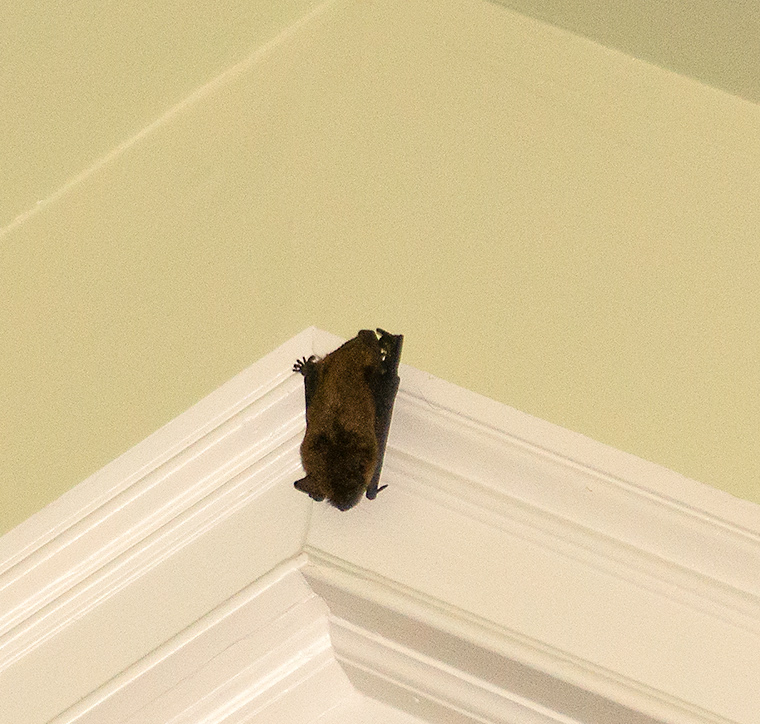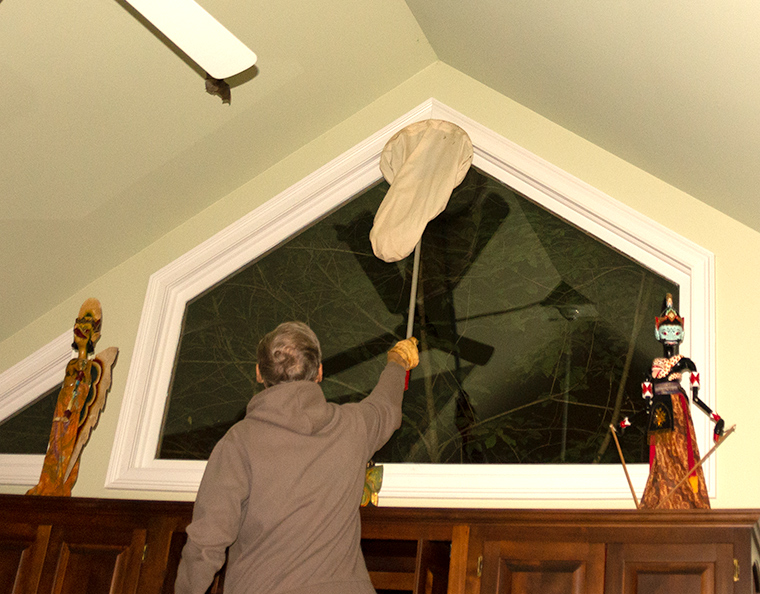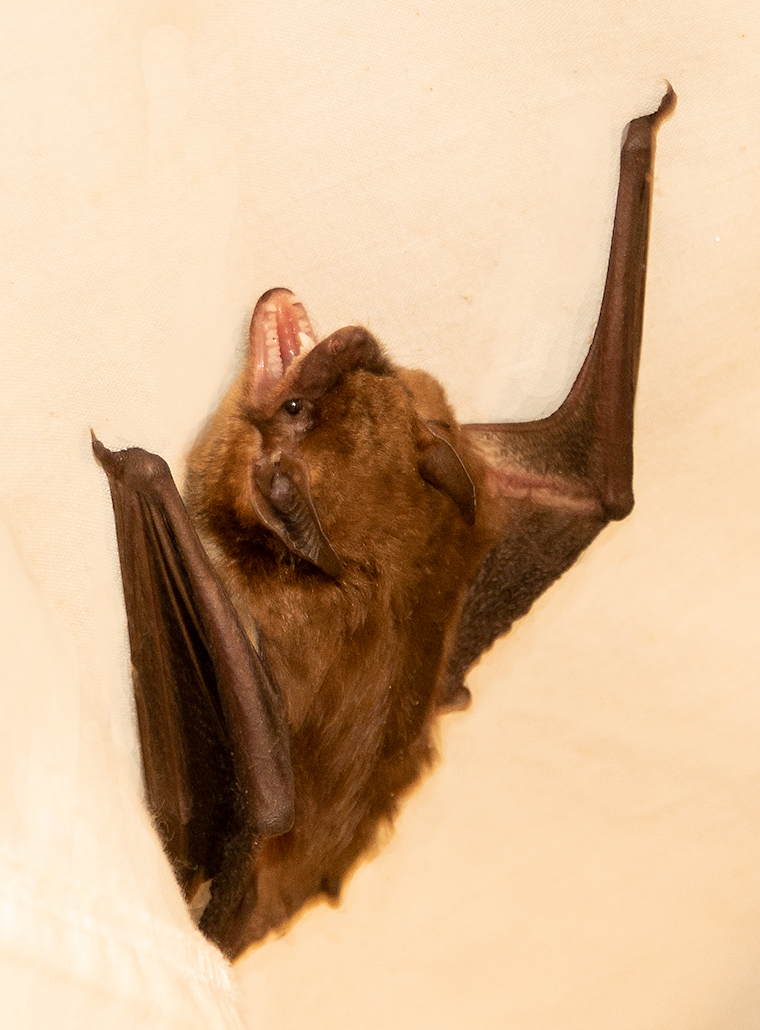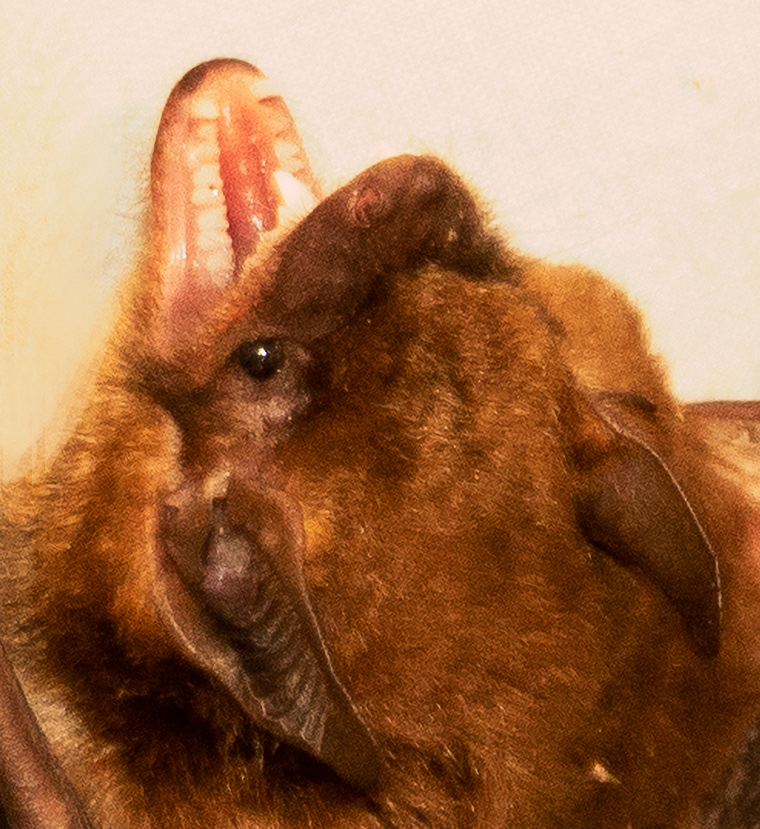 Joyce woke up around two AM and, in the dim light spotted a brown object at the top of the our bedroom molding. On closer examination, it turned out to be a bat.
Joyce woke up around two AM and, in the dim light spotted a brown object at the top of the our bedroom molding. On closer examination, it turned out to be a bat.
We didn’t want to harm the creature; we only wanted to get it safely out of the house. First we turned off the ceiling fan and retrieved my insect sweep net from the garage. Next we opened the bedroom door that leads outside onto a small deck. The door to the hallway was closed to isolate the bat into only one room (the bedroom).
 If I could have gotten higher, I would have tried to gently grab it with my gloved hand. In this case our best chance seemed for me to cover it with the net and get it to take off into the net. Oops! The bat took off before I could get the net over it. It can be spotted just below the fan blade.
If I could have gotten higher, I would have tried to gently grab it with my gloved hand. In this case our best chance seemed for me to cover it with the net and get it to take off into the net. Oops! The bat took off before I could get the net over it. It can be spotted just below the fan blade.
 The bat is in flight (you can see it just above the fan blade on the right). The wooden carved statue of Garuda also seems to be watching the bat!
The bat is in flight (you can see it just above the fan blade on the right). The wooden carved statue of Garuda also seems to be watching the bat!
The bat then began to fly around the bedroom in circles. We hoped at first it would fly out the open door to the outside. The bedroom has a high ceiling, however, and the bat never lowered its circles to the level of the open door.
My next ploy was to attempt to catch the bat in the net. After a few abortive attempts to catch it in the net, I was holding the net vertically, but not moving it and the bat flew into the net of its own accord!
I have twice captured bats in a fishing net, and both times they flew into it of their own accord. Also, many, many years ago I caught a flying bat in a seemingly impossible scenario. This occurred in the house of my friend, Skip, in Connecticut. The bat was flying around inside the house. With no other option, I grabbed a brown paper grocery bag and began trying to catch the bat. Success seemed supremely unlikely, but I had to try something. What do you know, the bat flew right into the bag! On reflection, it seems to me that the frightened creatures sought out the grocery bag or the fish net as a darker place that might offer some shelter and safety.
It is too bad we don’t have a sound recording of the bat’s flight. It must have been echolocating continuously while in flight.
 Here I am climbing down the ladder. I have flipped the net so that the bat is confined to the lower part of the net and cannot easily escape.
Here I am climbing down the ladder. I have flipped the net so that the bat is confined to the lower part of the net and cannot easily escape.
 We took the net out onto the deck and opened the net so the bat could crawl up and escape. I think this is a Little Brown Bat (Myotis lucifugus) or a Big Brown Bat (Eptesicus fuscus), but I cannot be sure which.
We took the net out onto the deck and opened the net so the bat could crawl up and escape. I think this is a Little Brown Bat (Myotis lucifugus) or a Big Brown Bat (Eptesicus fuscus), but I cannot be sure which.
Bat’s wings have the same basic set of bones as we do in our arms and hands. This photograph shows that the bat’s thumb is converted into a short, spiked appendage that is used to hold onto a perch and to climb. The swelling that is visible just above the left thumb is the bat’s wrist. The other four bones that correspond to (are homologous to) our four fingers are greatly elongated and support the wing when it is extended. See this link for good diagrams of the homologous structures.
 Here is a closeup of the bat’s face for a better look at its lower teeth and large ears. Bats are, of course, mammals, and they have teeth that can be classified as incisors, canines, premolars, and molars. This is not a great picture to show teeth, but it should be possible to make out the two large teeth at the top of the jaw. These are canines (sometimes called “fangs” in bats). The incisors are very small, but the premolars and some of the molars can be seen OK, if not very clearly. The large ears help in echolocation to find their way about and to capture prey.
Here is a closeup of the bat’s face for a better look at its lower teeth and large ears. Bats are, of course, mammals, and they have teeth that can be classified as incisors, canines, premolars, and molars. This is not a great picture to show teeth, but it should be possible to make out the two large teeth at the top of the jaw. These are canines (sometimes called “fangs” in bats). The incisors are very small, but the premolars and some of the molars can be seen OK, if not very clearly. The large ears help in echolocation to find their way about and to capture prey.
